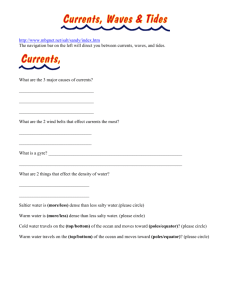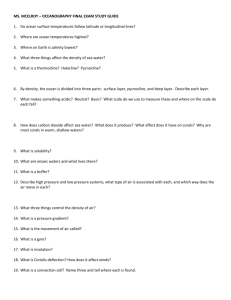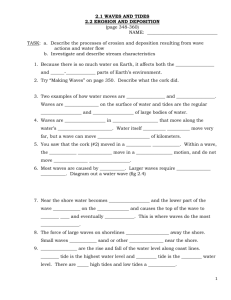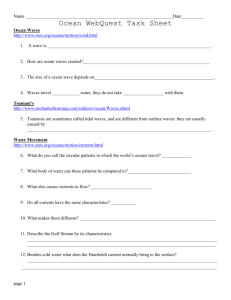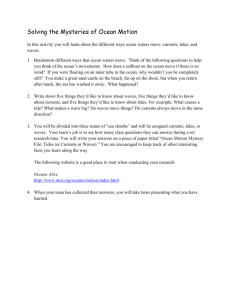AMS Ocean Studies
advertisement
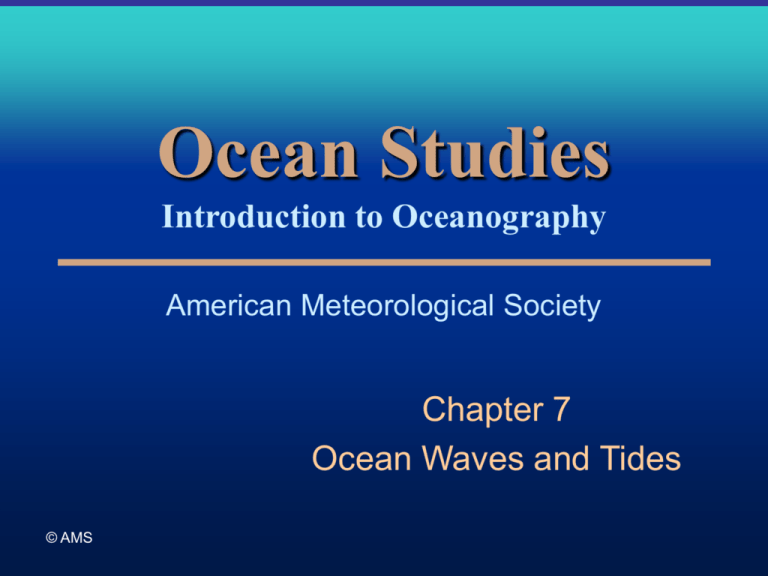
Ocean Studies Introduction to Oceanography American Meteorological Society Chapter 7 Ocean Waves and Tides © AMS Case in Point – Unusually high waves, known as rogue waves, occur in the open ocean as well as some coastal areas. – Many ships, including modern supertankers struck by rogue waves have been extensively damaged or sunk with loss of life. – By one convention, a wave is considered rogue if its height is 2.2 or more times the significant wave height (average height of the tallest one-third of waves observed in a patch of ocean). – Exceptionally high waves have been attributed to an amplifying interaction between waves, called constructive interference. – Rogue waves occur in all ocean basins, in stormy weather or under tranquil conditions, with a probability of >3% in any hour, and with little or no warning. © AMS Ocean Waves and Tides • Driving Question: – What are sea waves and tides and what causes them? © AMS Ocean Waves and Tides • In this chapter, we discuss – the formation and life cycle of waves, – their generation as wind-waves or “sea,” plus – their existence at sea as free waves and swell before expending their energy as breakers on a distant reef or shoreline. • We also describe internal waves and tsunamis. © AMS Wind-Driven Waves – A sea wave is an oscillation on the ocean surface that propagates along the interface between the atmosphere and ocean. – The highest point reached by the oscillating water surface is called the wave crest and the lowest point is the wave trough. – The wave height is the vertical distance between trough and crest. – The horizontal distance between successive wave crests (or equivalently between any other two corresponding points of two consecutive waves) is the wavelength. – The time needed for two successive wave crests (one wavelength) to pass a fixed point is the wave period. – The number of waves passing a fixed point over an interval of time is the wave frequency, the inverse of the wave period. © AMS Wind-Driven Waves Vertical cross-section of an idealized sea wave. © AMS Wind-Driven Waves • WIND-WAVE GENERATION – If the air over the ocean were always calm, the sea surface would be smooth and motion-less, a condition sailors refer to as flat calm. – Wind disturbs this equilibrium state as some of its kinetic energy is transferred to surface ocean waters as the wave-generating force. – Waves begin as small ripples, called capillary waves, with wavelengths of less than 1.7 cm (0.7 in.). At these short wavelengths, water’s surface tension is the restoring force that smoothes out and flattens these relatively small waves. © AMS Wind-Driven Waves • WIND-WAVE GENERATION – Strengthening winds increasingly disturb the water surface, producing larger waves having longer wavelengths and greater wave heights. – For these larger waves, gravity is the restoring force working to level the wave crests and fill in the wave troughs. • Gravity pulls the crested water downward, but momentum causes the water to continue downward and a trough is formed. The lowered water is buoyed upward and the next crest rises. – Wind and gravity are responsible for most waves observed on the ocean surface. © AMS Wind-Driven Waves As a wave propagates along the air/ocean interface, water particles oscillate in approximately circular orbits. In relatively deep water, the orbital diameter of a water particle at the ocean surface equals the wave height. As a complete wave passes a fixed point, a water particle completes one orbit and returns to approximately its original location. Orbits decrease in diameter with depth below the water surface and eventually dissipate completely. This depth of no wave motion, called wave-base, approximately corresponds to one-half the wavelength. © AMS Wind-Driven Waves • WIND-WAVE GENERATION – No net horizontal transport of water mass occurs with each wave cycle. Instead, the wave’s energy is propagated in packets in the direction of travel. – A wave crest travels twice as fast as the wave energy • a wave arises in the back of the packet, grows in height, moves through the packet twice as fast as the packet, and disappears at the front of the packet. © AMS Wind-Driven Waves • WIND-WAVE GENERATION – Water wave formation and evolution depend primarily on the wind’s • • • • speed, turbulence, duration (the length of time the wind blows from the same direction) and fetch (the distance the wind blows over a continuous water surface). – In general, waves continue to build in height and length as long as the energy supplied to the waves by winds exceeds the amount of energy dissipated in breaking waves. © AMS • When the amount of dissipated energy equals the amount of energy supplied by the wind, no further wave build up occurs. Wind-Driven Waves • WIND-WAVE GENERATION – Wave interference also influences the growth and decay of sea waves. © AMS • In constructive wave interference, two or more wave crests coincide to form composite waves having heights greater than any of the original wave components (e.g. rogue waves). • On the other hand, sets of waves can also interact such that the crests in one set of waves coincide with the troughs in another set, partially canceling both sets. The product is a composite wave whose height is smaller than that of the original wave components. This interaction is known as destructive wave interference. • Both types of wave interference are almost always happening at sea and contribute to the continually changing pattern of waves on the open ocean. Wind-Driven Waves • DEEP-WATER AND SHALLOW-WATER WAVES – An ocean surface disturbed by winds becomes a mass of waves of various heights and lengths, moving in many different directions. This condition is known as sea. – Waves continue to propagate well beyond the area of strong storm winds. Such waves, called swell, are lower and more rounded than waves forming directly under the storm winds. – Celerity is the speed of the wave relative to the water. © AMS Wind-Driven Waves • DEEP-WATER AND SHALLOW-WATER WAVES – Waves in water that is deeper than their wave-base are known as deep-water waves. – The celerity of deep-water waves depends on wavelength and gravity and can be computed using the formula: C =√(1.56 × wavelength), where C is the celerity in m per sec and the wavelength is given in meters. © AMS Wind-Driven Waves • DEEP-WATER AND SHALLOW-WATER WAVES – In relatively deep water, waves with longer wavelengths travel faster than waves with shorter wavelengths. – With deep-water waves, there is no interaction between the orbital motions of the wave and sea bottom. – With little dissipation due to friction, swell can travel thousands of kilometers from its source. © AMS Wind-Driven Waves • DEEP-WATER AND SHALLOW-WATER WAVES – When waves enter waters shallower than wave-base, they are restricted by water depth. – These are now shallow-water waves where the orbits of water particles gradually flatten with increasing depth, changing to a backand-forth motion near the bottom. – Wave period is unchanged so its wavelength shortens, and its wave height increases. © AMS Wind-Driven Waves • DEEP-WATER AND SHALLOW-WATER WAVES – When waves enter waters having a depth of less than one-half the wavelength, the wave celerity depends on water depth and gravity but not wavelength and is computed as: C = √(g × depth) where C is the celerity in m per sec, g is gravity, and depth is given in meters. – Shallow-water waves slow as they enter © AMS shoaling water Wind-Driven Waves In shallow-water waves, the orbits of water particles gradually flatten with increasing depth, changing from circular to elliptical and ultimately to a back-and-forth motion near the ocean bottom. © AMS Wind-Driven Waves • DEEP-WATER AND SHALLOW-WATER WAVES – Waves break when the ratio of wave height to wavelength approaches 1 to 7; at this point the wave-crest angle is close to 120 degrees. – Wave energy is dissipated when breakers form. – A nearly continuous train of waves breaking along a shore is called surf. © AMS Wind-Driven Waves As the water shoals, particles of water in the building wave crest move forward faster than the wave propagates toward shore. The wave becomes steeper and eventually unstable. When the ratio of wave height to wavelength approaches 1 to 7, the crest plunges forward as a breaker. © AMS Wind-Driven Waves • SEICHE – A seiche is a rhythmic oscillation of water in an enclosed basin. – Unlike wind-driven progressive waves, a seiche is a standing wave; crests alternate vertically with troughs but at fixed locations. – During a seiche, the water level in a basin commonly rises at one end while simultaneously falling at the other end. – Water level near the center (node) does not change at all. – This is analogous to the motion of a seesaw. © AMS Wind-Driven Waves A seiche in an enclosed basin with a single node. The maximum vertical © AMS motion of the water takes place at the antinodes and the maximum horizontal motion occurs at the node. Wind-Driven Waves • SEICHE – Wind, air pressure gradients, earthquakes, or astronomical tides can induce a seiche. – The natural period of a seiche is directly proportional to basin length and inversely proportional to water depth. – A seiche grows as a consequence of resonance meaning that the period of the disturbance (e.g., earthquake, wind) matches the natural period of oscillation of the basin. © AMS Wind-Driven Waves • WAVE MEDIATED ATMOSPHERE-OCEAN TRANSFER – Sea waves help bring about transfer of energy and matter between the atmosphere and ocean, a major interaction among subsystems of the Earth system. • The largest wind-generated waves on the ocean surface are important in driving ocean currents by transferring momentum from the wind to ocean surface waters. • Waves with shorter wavelengths play a major role in heat transfer from the ocean surface to the atmosphere through latent heating and sensible heating. © AMS Wind-Driven Waves • WAVE MEDIATED ATMOSPHERE-OCEAN TRANSFER – Waves with shorter wavelengths (especially breaking waves) deliver tiny salt particles to the atmosphere where they function as cloud condensation nuclei spurring development of clouds. • Droplets of ocean spray transfer microscopic marine algae and viruses into the atmosphere where winds can transport them long distances. • Breaking waves capture myriads of air bubbles that are dissolved and carried tens of meters below the ocean surface. © AMS – This process, known as bubble injection, is an important source of dissolved oxygen and carbon dioxide for surface waters. Internal Waves – Internal waves form within the ocean along interfaces where the change in density with depth is relatively abrupt. – Favorable sites for development of internal waves include the base of the mixed layer and interfaces (pycnoclines) between water masses having different densities. – Internal waves also form in estuaries along the pycnocline between fresh river water and salty ocean water. © AMS Ocean Tides – Astronomical tides are the regular rise and fall of the sea surface caused by the gravitational attraction between the rotating Earth and the moon and sun. – Tides are shallow-water waves so that wave celerity depends on water depth. • For an average ocean depth of 4000 m (13,000 ft), tidal celerity is about 200 m per sec (400 mph). – Tides are measured mostly at coastal locations as local changes in water level © AMS through time. Ocean Tides Note the watermark on the dock indicating the level of the water at high tide. The average vertical difference in height between water levels at high and low tides is called the tidal range and generally varies between less than a meter to several meters. The time between successive high tides is the tidal period. © AMS Ocean Tides • TIDE-GENERATING FORCES – Produced by the combination of • the gravitational attraction between Earth and the moon and sun; • the rotations of the Earth-moon and Earth-sun systems. – According to the law of universal gravitation, the gravitational attraction between two bodies is directly proportional to the product of the masses of the two bodies and inversely proportional to the square of the distance between them. © AMS • For this reason, the moon exerts a greater gravitational pull on Earth. Ocean Tides Two ocean tidal bulges produced by the gravitational attraction of the moon combined with the rotation of the Earth-moon system on an idealized water-covered Earth. © AMS Ocean Tides • TIDE-GENERATING FORCES – The gravitational pull of the moon on Earth is primarily responsible for the bulge in the ocean surface that is oriented toward the moon. – Newton’s first law of motion predicts that a net force must operate in any rotating system. • This net force in the rotating Earth-moon system gives rise to the tidal bulge on the planet opposite the moon. – In the equilibrium model of tides, which assumes a frictionless Earth entirely covered by water, ocean bulges would always align with the celestial body that caused them and any location moving through these bulges would experience tides. • If only one celestial body was present, each day a low-latitude location would experience two high tides and two low tides. © AMS • If the positions of the Earth and moon remained fixed in space, the period of these tidal waves would be 12 hrs. Ocean Tides • TIDE-GENERATING FORCES – While the Earth is rotating, the moon is rotating around Earth. • This gives rise to the tidal day (24 hrs, 50 minutes). • The times of high and low tide change by about 50 minutes from one solar day to the next. • The ocean’s tidal bulges produced by the moon remain in the same alignment relative to the moon, but change their latitudinal positions on Earth as they follow the moon during its monthly revolution about Earth. – Sun-related tidal bulges are produced in the same way as those caused by Earth-moon interactions. • The sun’s tidal pull is about 46% of the moon’s pull. – The tide-generating force is inversely proportional to the cube of the distance between Earth and another © AMS celestial body. • Diurnal Tide – Period of 24 hrs and 50 min • Semi-diurnal Tide – Two equal high tides and two equal low tides per day – Period of 12 hrs and 25 min • Mixed Tide – Two unequal high tides and two unequal low tides per day – Difference in height between successive high (or low) tides is the diurnal inequality • Maximum – tropic tides • Minimum – equatorial tides © AMS (A) Spring tides occur twice each month at or near the times of new moon and full moon when the gravitational pull of the sun reinforces that of the moon; this causes an unusually large or increased tidal range. (B) Neap tides have the least monthly tidal range occurring at the first and third quarter phases of the moon, when the sun’s pull on Earth is at right angles to the pull of the moon. © AMS Ocean Tides • TIDES IN OCEAN BASINS – Many non-astronomical forces modify tides, including ocean-bottom topography, the presence of continents, coastline configuration, the Coriolis Effect, winds, and water depth. – The dynamic model of tides applies reasonably well to seas and large embayments as well as the open ocean. © AMS • As Earth rotates from west to east, the tidal bulge shifts toward the western boundary of the ocean basin and the water surface slopes gently downward toward the east. • The tidal crest rotates around the basin in a counterclockwise direction (Northern Hemisphere) due to the Coriolis Effect. • When the tide is high on one side of the basin, it is low on the opposite side. In this idealized Northern Hemisphere ocean basin bordered on all sides by land (top), a tide wave rotates in a counterclockwise direction (viewed from above). Lines radiating outward from the central node are cotidal lines that join points where high tide occurs at the same tide of day. This is a semi-diurnal tide. Also shown (bottom) is a vertical cross-section from point A to point B. Note that the tidal range varies from zero at the node to a maximum at the antinodes. © AMS Ocean Tides • TIDES IN OCEAN BASINS – The natural period of oscillation of a shallow basin may match the period of the tide-generating force causing resonance. • Example: Bay of Fundy has tidal range up to 16 m (53 ft) during spring tide – Non-astronomical factors explain why locations on the U.S. Atlantic coast have predominately semi-diurnal tides whereas many places on the Gulf Coast have mostly diurnal tides, and localities on the Pacific Coast and portions of Canada’s Atlantic coast have mostly mixed tides. © AMS ASTER satellite image of the Bay of Fundy, Nova Scotia, Canada, at high tide (top) on 20 April 2001, and low tide (bottom) on 30 September 2002. The world’s highest astronomical tides (tidal range of 16 m) occur in Minas Basin at the eastern extremity of the Bay of Fundy due to resonance of the Bay of Fundy-Gulf of Maine system; that is, the natural period of oscillation of about 13 hrs is close to the 12 hrs 25 min period of the lunar tide of the Atlantic Ocean. © AMS Ocean Tides • TIDAL CURRENTS – Alternating horizontal movements of water accompanying the rise and fall of astronomical tides in coastal areas are known as tidal currents. – When tidal currents are directed toward the land, water levels rise in harbors and rivers; these are called flood tides – Tidal currents flowing seaward with falling sea levels are called ebb tides. – In some coastal areas where the tidal range is relatively large and the flood tide enters a narrow bay or channel, a tidal bore forms and moves upstream in a river or shallow estuary. A tidal bore is a wall of turbulent water, usually less than a meter in height. © AMS Ebb tide and flood tide in a harbor viewed from above. © AMS Ocean Tides • OBSERVING AND PREDICTING TIDES – Prediction is relatively simple and is very important for major ports. – Tides are waves so that local tides can be resolved mathematically into the various components, called partial tides. © AMS • Some 60 components are commonly used. • More than 100 components may be used to predict tides along a complex coastline. Ocean Tides • OPEN-OCEAN TIDES – These are important in mixing deep-ocean water. – Tidal currents flowing over topographic irregularities on the ocean floor generate internal tide waves that propagate away from their source. • Can travel thousands of kilometers from their source and can have very large wavelengths • Can break like surf on a beach, but under water, locally mixing waters • Are important in mixing cold bottom waters with warmer surface waters • Can influence the gradient of the continental slope © AMS Tsunami – A rapidly propagating shallow-water wave that develops when a submarine earthquake, landslide, or volcanic eruption disrupts deep ocean water – Wave is unnoticed moving under a ship at ship, but can build to tremendous height in shoaling coastal waters – Can have a long reach, transporting potentially destructive energy from its source to coastlines many thousands of kilometers away – Threat is generally much greater in the Indian and Pacific Oceans than in the Atlantic Ocean – A tsunami on 26 December 2004 devastated portions of the coastal area rimming the Indian Ocean and claimed an estimated 230,000 lives, the highest death toll ever recorded by a tsunami. © AMS Tsunami The Scotch Cap Lighthouse on Unimak Island, Alaska before and after the earthquake and tsunami of April 1946. A magnitude 8.0 (Mw) earthquake with the source to the south of Unimak Island generated a tsunami that destroyed the five-story lighthouse, located 9.8 m above sea level. © AMS Tsunami – The Hawaiian tsunami of 1946 led to the establishment of the Pacific Tsunami Warning Center in 1948. – Warnings are based on earthquakes occurrences detected by seismic networks around the Pacific Rim plus tide gauge readings in coastal areas. – Issues include: • a high false alarm ratio; • undersea earthquakes do not always generate a tsunami; • warnings provided by coastal tide gauges generally arrive too late for adequate warning of the public. – Prior to the December 2004 tsunami, there was no warning system in the Indian Ocean © AMS • An international effort lead by UNESCO has been rectifying the situation. Saving lives through improved early warning of an approaching tsunami is the goal of the NOAA Deep-ocean Assessment and Reporting of Tsunamis (DART) system. Each DART station has a tsunameter, consisting of a pressure sensor anchored to the ocean floor at depths to 500 m (1640 ft) that measures slight variations in pressure exerted by the overlying water column in response to a passing tsunami wave. This map shows the location of completed and planned DART and Tsunameter Stations as of November 2007 for real-time detection of tsunamis. © AMS Data from DART sensors are essential components of the U.S. National Tsunami Hazard Mitigation Program, a partnership that includes representatives of various federal agencies (i.e., NOAA, FEMA, and the U.S. Geological Survey) and the Pacific Coast states. In recent years, this program has also installed new shore-based tide gauges and upgraded seismometers operated by the USGS. An essential outcome of the program is public awareness of the tsunami hazard and the construction of maps that identify coastal areas most susceptible to inundation by a tsunami. © AMS Conclusions – Winds supply the kinetic energy that forms waves on the ocean surface, which then propagate horizontally until they expend their energy by breaking on a distant shore. – Wave behavior depends on wind speed, fetch, and duration as well as water depth. – In terms of interaction with the ocean bottom, a distinction is made between deep-water waves and shallow-water waves. – The gravitational attraction of the moon and sun combined with the rotations of the Earth-moon and Earth-sun coupled systems generate planetary-scale shallow-water tide waves in the ocean basins. © AMS

